No wave was an avant-garde music genre and visual art scene that emerged in the late 1970s in Downtown New York City. The term was a pun based on the rejection of commercial new wave music. Reacting against punk rock's recycling of rock and roll clichés, no wave musicians instead experimented with noise, dissonance, and atonality, as well as non-rock genres like free jazz, funk, and disco. The scene often reflected an abrasive, confrontational, and nihilistic world view.

Ludlow Street runs between Houston and Division streets on the Lower East Side of Manhattan in New York City. Vehicular traffic runs south on this one-way street.
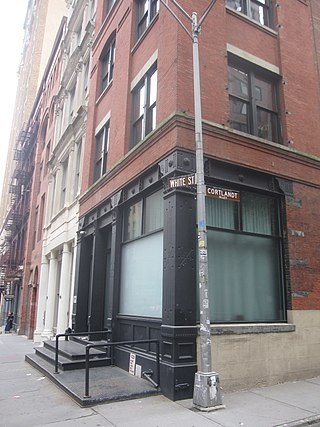
The Mudd Club was a nightclub located at 77 White Street in the TriBeCa neighborhood of Lower Manhattan in New York City. It operated from 1978 to 1983 as a venue for post punk underground music and no wave counterculture events. It was opened by Steve Mass, Diego Cortez and Anya Phillips.

The Pyramid Club was a nightclub in the East Village of Manhattan, New York City. After opening in 1979, the Pyramid helped define the East Village drag queen, gay, post-punk and no wave art and music scenes of the 1980s. The club was located at 101 Avenue A in Manhattan.

Gordon Stevenson was an artist, actor, musician and filmmaker who died of AIDS in 1982, one of the East Village art community’s first casualties of the AIDS epidemic.
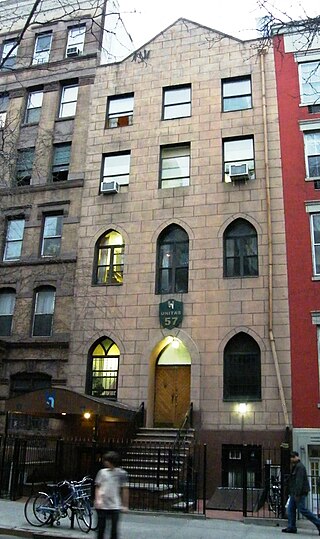
Club 57 was a nightclub located at 57 St. Mark's Place in the East Village, New York City during the late 1970s and early 1980s. It was originally founded by Stanley Zbigniew Strychacki as well as Dominic Rose, then enhanced by nightclub performer Ann Magnuson, Susan Hannaford, and poet Tom Scully. It was a hangout and venue for performance and visual artists and musicians, including The Cramps, Madonna, Keith Haring, Cyndi Lauper, Charles Busch, Klaus Nomi, The B-52s, RuPaul, Futura 2000, Tron von Hollywood, Kenny Scharf, Frank Holliday, John Sex, Wendy Wild, The Fall, April Palmieri, Peter Kwaloff, Robert Carrithers, The Fleshtones, The Fuzztones, Joey Arias, Lypsinka, Michael Musto, Marc Shaiman, Scott Wittman, Fab Five Freddy, Jacek Tylicki, and to a lesser extent, Jean-Michel Basquiat.
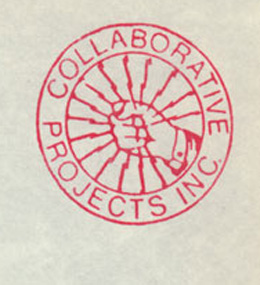
Colab is the commonly used abbreviation of the New York City artists' group Collaborative Projects, which was formed after a series of open meetings between artists of various disciplines.
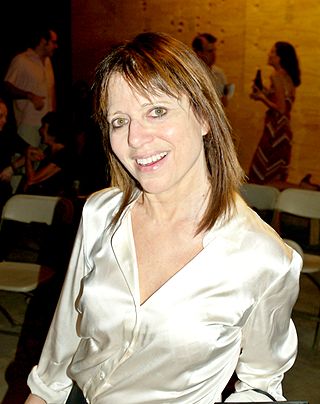
Judy Rifka is an American artist active since the 1970s as a painter and video artist. She works heavily in New York City's Tribeca and Lower East Side and has associated with movements coming out of the area in the 1970s and 1980s such as Colab and the East Village, Manhattan art scene.

Launched from the Lower East Side, Manhattan in 1983 as a subscription only bimonthly publication, the Tellus Audio Cassette Magazine utilized the audio cassette medium to distribute no wave downtown music and audio art and was in activity for the ten years of 1983–1993.
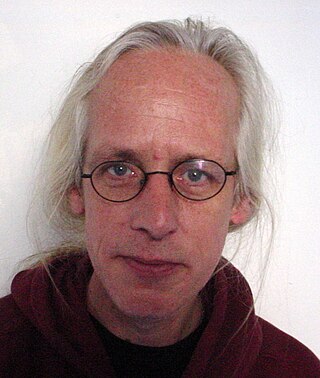
Carlo McCormick is an American culture critic and curator living in New York City. He is the author of numerous books, monographs and catalogues on contemporary art and artists.

Tier 3 was an influential but short-lived 300-capacity no wave art nightclub in New York. Founded by Hilary Jaeger in 1979, Tier 3 was a major venue in the city's underground music and counterculture post-punk art scene, along with the Mudd Club. Live performances showcased punk rock, no wave, ska, noise music, free jazz, new wave and experimental music. The club was located at 225 West Broadway in the TriBeCa neighborhood of lower Manhattan.
Ground Zero Gallery was an art gallery formed in the East Village of Manhattan in New York City in mid-1983 as a vehicle for the partnership of artist James Romberger and his co-founder Marguerite Van Cook. In 1984, the gallery found its first physical home on East 11th Street and showed the work of many East Village artists who went on to gain national recognition. It was an early proponent of installation art. Ground Zero was the production name for many projects in various media undertaken by the team of Van Cook and Romberger prior to the September 11 attacks.
Dancenoise is an American performance art duo created by Anne Iobst and Lucy Sexton. Dancenoise entered the New York and Washington, D.C., art and club scene in 1983, performing at venues such as WOW Café, the Pyramid, 8BC, Performance Space 122, Franklin Furnace, The Kitchen, La Mama, Danspace Project, and King Tut’s Wah Wah Hut. Their work has also been presented around Europe as well as at the Lincoln Center for the Performing Arts. Dancenoise has also collaborated with other artists including Charles Atlas, Mike Taylor, Ishmael Houston-Jones, and Yvonne Meier. In addition to their work under the title Dancenoise, Iobst and Sexton, along with Jo Andres and Mimi Goese, were frequent collaborators with Tom Murrin, an East Village performance artist known for his monthly celebrations in honor of the full moon. Dancenoise is a recipient of National Endowment of the Arts Choreographic Fellowships and a Bessie Award for New York Dance and Theatre.

Walter Robinson is an American painter, publisher, art curator, and art writer, based in New York City. He has been called a Neo-pop painter, as well as a member of the 1980s The Pictures Generation. Robinson is the subject of the 632 page book A Kiss Before Dying: Walter Robinson – A Painter of Pictures and Arbiter of Critical Pleasures by Richard Milazzo published in 2021 with an Italian translation by Ginevra Quadrio Curzio.
Eric Mitchell is a French born writer, director, and actor who moved to downtown New York City in the early 1970s. He has acted in many No Wave films such as Permanent Vacation (1980) by Jim Jarmusch, but is best known for his own films that are usually written and directed by him: Kidnapped, Red Italy, Underground U.S.A. and The Way It Is or Eurydice in the Avenues, starring Steve Buscemi, Vincent Gallo, Mark Boone Junior and Rockets Redglare. Mitchell worked out of New York City's sordid East Village area in conjunction with Colab and other performance artists and noise musicians. There he created a series of scruffy, deeply personal, short Super 8mm and 16mm films in which he combined darkly sinister images to explore the manner in which the individual is constrained by society.

James Allan Curtis, known professionally as Diego Cortez, was an American filmmaker and art curator closely associated with the no wave period in New York City. Cortez was the co-founder of the Mudd Club, and he curated the influential post-punk art show New York/New Wave, which brought the then aspiring artist Jean-Michel Basquiat to fame.
Mitch Corber is a New York City neo-Beat poet, an eccentric performance artist, and no wave videographer known for his rapid whimsically comical montage and collage style. He has been associated with Collaborative Projects, Inc., participated in Public Arts International/Free Speech and The Times Square Show, and is creator-director of cable TV long-running weekly series Poetry Thin Air in New York City and its on-line poetry/video archive. He has worked closely with ABC No Rio, Colab TV and the MWF Video Club and his audio art have been published on Tellus Audio Cassette Magazine three times. He is a recipient of a NY Foundation for the Arts Fellowship grant (1987) in the field of emerging artforms.

The Real Estate Show was a short-term occupation art exhibition held on New Year's Day in a vacant city-owned building at 123 Delancey Street in the Lower East Side of Manhattan, New York City by New York artists' group Colab. As stated in “The Real Estate Show Manifesto or Statement of Intent”, the subject of the exhibition was resistance to abusive landlord speculation within the real estate industry.
Tessa Hughes-Freeland is a British-born experimental film maker, writer living in New York City. Her films have screened internationally in North America, Europe and Australia and in prominent museums and galleries, including the Museum of Modern Art (MOMA); the Museum of Contemporary Art, Los Angeles; the Whitney Museum of American Art; the New Museum of Contemporary Art in New York; and the KW Institute of Contemporary Art in Berlin. She has collaborated on live multi-media projects with musicians like John Zorn and J. G. Thirlwell. She and Ela Troyano co-founded the New York Film Festival Downtown in 1984 and served as its co-directors until 1990. Hughes-Freeland later served as President of the Board of Directors of the Film-Makers Co-Operative in New York City from 1998-2001. She has published articles in numerous books, including “Naked Lens: Beat Cinema” and “No Focus: Punk Film,” and in periodicals including PAPER Magazine, Filmmaker magazine, GQ, the East Village Eye, and Film Threat.

The Times Square Show was an influential collaborative, self-curated, and self-generated art exhibition held by New York artists' group Colab in Times Square in a shuttered massage parlor at 201 W. 41st and 7th Avenue during the entire month of June in 1980. The Times Square Show was largely inspired by the more radical Colab show The Real Estate Show, but unlike it, was open 24 hours a day, 7 days a week, in what was then a Times Square full of porno theaters, peep shows, and red light establishments. In addition to experimental painting and sculpture, the exhibition incorporated music, fashion, and an ambitious program of performance and video. For many artists the exhibition served as a forum for the exchange of ideas, a testing-ground for social-directed figurative work in progress, and a catalyst for exploring new political-artistic directions.















